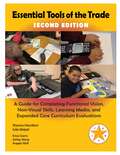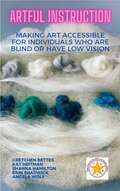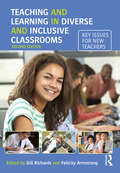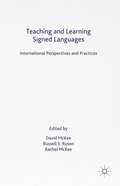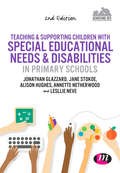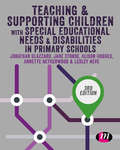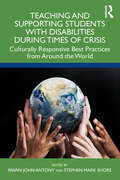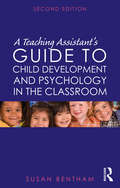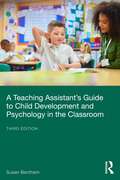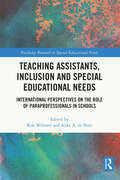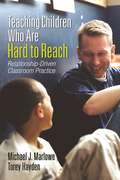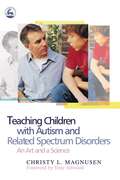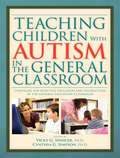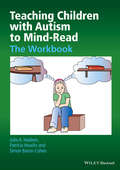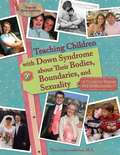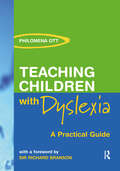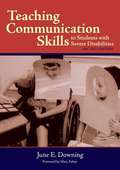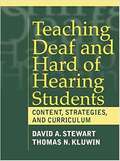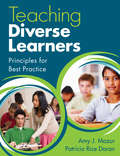- Table View
- List View
Teaching Age-Appropriate Purposeful Skills: Street Crossings for Travelers Who Are Visually Impaired
by Linda Myers Wendy SchiffersIt helps travelers lower the inherent risk in crossing streets. Travelers who learn and apply this information will be safer and better able to travel independently in familiar and unfamiliar areas with less need for mobility instruction in the future.
Teaching Age-Appropriate Purposeful Skills: Comprehensive Initial and Ongoing Evaluation
by Rona Pogrund Debra Sewell Heidi Anderson Lisa CalaciA comprehensive evaluation tool is designed to be used by trained orientation and mobility specialists to identify a student's current functioning level in all areas of orientation and mobility in order to determine student needs for programming
Teaching Age-Appropriate Purposeful Skills: The Curriculum)
by Rona Pogrund Debra Sewell Heidi Anderson Lisa Calaci Mary Faith Cowart Carolina M. Gonzalez Ruth Ann Marsh Burnsteen Roberson-SmithAn Orientation and Mobility curriculum for teachers and specialists to help visually challenged students realize a fundamental right to independent and fulfilling life : being able to travel whenever and wherever an individual wants to go.
Teaching Age-Appropriate Purposeful Skills Part 3 Appendices
by Rona Pogrund Debra Sewell Heidi Anderson Lisa Calaci [et al.]An Orientation & Mobility Curriculum for Students With Visual Impairments 3rd Edition
Teaching and Learning in Diverse and Inclusive Classrooms: Key issues for new teachers
by Felicity Armstrong Gill RichardsThis accessible text focuses on diversity in education and the inclusion of all children and young people in all aspects of the school or college community. It provides an introduction to policy, theory and practical strategies in relation to diversity in education for practitioners, researchers and policy makers. The fully revised and updated chapters discuss recent debates, research studies and current initiatives, particularly relating to teaching and learning, and conclude with key questions for student reflection. Topics include: Inclusive education ethnic and cultural diversity challenging behaviour bullying gender identity and sexuality Gypsy, Roma and Traveller children special educational needs listening to parents religious and cultural diversity disability and human rights children and young people who are refugees or seeking asylum Reflecting on legislative duties, personal values and the importance of listening to the voice of all learners, particularly those who may experience disadvantage or discrimination in educational settings, Teaching and Learning in Diverse and Inclusive Classrooms is a key resource for initial teacher training programmes and professional development courses.
Teaching and Learning Signed Languages
by David Mckee Russell S. Rosen Rachel MckeeTeaching and Learning Signed Languages examines current practices, contexts, and the research nexus in the teaching and learning of signed languages, offering a contemporary, international survey of innovations in this field.
Teaching and Supporting Children with Special Educational Needs and Disabilities in Primary Schools (Achieving QTS Series)
by Jonathan Glazzard Alison Hughes Annette Netherwood Lesley Neve Jane StokoeIf you are a primary trainee, or are training to support children in primary schools, this is your guide to working with children with Special Educational Needs and Disabilities (SEND). We begin by exploring what is meant by SEND in primary schools and go on to cover all you need to know about your statutory responsibilities in school. Current legislation and the Code of Conduct are covered, to give you lots of information about the content you will be working in. The book then examines the range of needs you will encounter in primary schools giving you details information and practical advice. This second edition has been fully restructured and updated to include a new section on the key theory relating to SEND. Exploring theories and theorist that you will need to know about to fully understand how to support children. Also new for this edition is a chapter focusing on the role of the SENCO in the primary school. Finally, the book includes more practical support to help you in the classroom. Checklists to help you to work comprehensively and information about useful resources and outside agencies.
Teaching and Supporting Children with Special Educational Needs and Disabilities in Primary Schools (Achieving QTS Series)
by Jonathan Glazzard Alison Hughes Annette Netherwood Lesley Neve Jane StokoeThis book begins by exploring what is meant by SEND in primary schools and goes on to cover everything trainees and teachers need to know about their statutory responsibilities in school. It then examines the range of needs they will encounter in primary schools with plenty of practical advice along the way. This third edition has been fully restructured and updated to include a new section on the key theories and theorists relating to SEND. Also new to this edition is a chapter focusing on the role of the SENCO in primary school. Finally, the book includes more practical support with coverage of current legislation and the Code of Conduct as well as checklists and information about useful resources and outside agencies.
Teaching and Supporting Children with Special Educational Needs and Disabilities in Primary Schools (Achieving QTS Series)
by Jonathan Glazzard Alison Hughes Annette Netherwood Lesley Neve Jane StokoeThis book begins by exploring what is meant by SEND in primary schools and goes on to cover everything trainees and teachers need to know about their statutory responsibilities in school. It then examines the range of needs they will encounter in primary schools with plenty of practical advice along the way. This third edition has been fully restructured and updated to include a new section on the key theories and theorists relating to SEND. Also new to this edition is a chapter focusing on the role of the SENCO in primary school. Finally, the book includes more practical support with coverage of current legislation and the Code of Conduct as well as checklists and information about useful resources and outside agencies.
Teaching and Supporting Children with Special Educational Needs and Disabilities in Primary Schools (Achieving QTS Series)
by Jonathan Glazzard Jane Stokoe Alison Hughes Annette Netherwood Lesley NeveIf you are a primary trainee, or are training to support children in primary schools, this is your guide to working with children with Special Educational Needs and Disabilities (SEND). We begin by exploring what is meant by SEND in primary schools and go on to cover all you need to know about your statutory responsibilities in school. Current legislation and the Code of Conduct are covered, to give you lots of information about the content you will be working in. The book then examines the range of needs you will encounter in primary schools giving you details information and practical advice. This second edition has been fully restructured and updated to include a new section on the key theory relating to SEND. Exploring theories and theorist that you will need to know about to fully understand how to support children. Also new for this edition is a chapter focusing on the role of the SENCO in the primary school. Finally, the book includes more practical support to help you in the classroom. Checklists to help you to work comprehensively and information about useful resources and outside agencies.
Teaching and Supporting Students with Disabilities During Times of Crisis: Culturally Responsive Best Practices from Around the World
by Pavan John Antony Stephen Mark ShoreThis volume offers international perspectives on the disproportionate impact COVID-19 has had on disabled students and their families, serving as a call to action for educational systems and education policy to become proactive, rather than reactive, for future disasters. Each chapter in the book is written by authors with lived experiences across diverse global regions, highlighting the daily life of people with disabilities and their families during the pandemic. Including case studies and practical suggestions, the book demonstrates that culturally responsive practices are essential to successfully support people around the world in their times of need. At the critical intersection of education and disability human rights, this book is important for pre-service teachers, researchers, professors, and graduate students to ensure all students are supported during times of crisis.
A Teaching Assistant's Guide to Child Development and Psychology in the Classroom: Second edition
by Susan BenthamHow can you help students most effectively in the classroom? As a Teaching Assistant, you play a vital role in today’s schools. This fully updated new edition will help you get to grips with the main issues to do with psychology and its role in the processes of teaching and learning. This accessible text, building on the success of a best-selling previous edition, provides informative, yet down-to-earth commentary with clear examples of how you can apply this knowledge in everyday practice. The book addresses issues including: how to support learning how to identify and cater for different learning styles teaching children with additional needs how to manage behaviour to support learning how to help children with their self-esteem and independence. This new edition includes references to up-to-date research in child development and psychology to include information regarding personalised learning, creativity, motivation, friendships skills, moral development and neuroscience. Chapters are complemented with lively case studies, self-assessment questions and examples of how to apply theory to everyday classroom practice. The reader is encouraged to develop reflective practice to best support childrens’ behaviour and learning. This reader-friendly book is an invaluable companion for every Teaching assistant, HLTA, Cover Supervisor, and anyone working in a supporting role in an educational setting.
A Teaching Assistant’s Guide to Child Development and Psychology in the Classroom
by Susan BenthamHow can you help students most effectively in the classroom? As a teaching assistant, you play a vital role in today’s schools. This fully updated third edition will help you get to grips with the main issues to do with psychology and its role in the processes of teaching and learning.This accessible text provides informative, yet down-to-earth commentary with clear examples of how you can apply this knowledge in everyday practice. This book addresses issues such as how to support learning and behaviour, how to create an optimal learning environment for all students, ways to encourage pupil voice, supportive strategies for children with additional needs, and how to help children with their self-esteem and independence. This new edition includes references to up-to-date research in child development and psychology to include information regarding wellbeing, mental health, and learning strategies related to insights from cognitive science. Chapters are complemented with lively case studies, self-assessment questions, and examples of how to apply theory to everyday classroom practice. The reader is encouraged to develop reflective practice to best support children’s behaviour and learning.This reader-friendly book is an invaluable companion for every teaching assistant, HLTA, pastoral support assistant, learning mentor, classroom cover supervisor and anyone working in a supporting role in an educational setting.
Teaching Assistants, Inclusion and Special Educational Needs: International Perspectives on the Role of Paraprofessionals in Schools (Routledge Research in Special Educational Needs)
by Rob Webster Anke A. de BoerThis book offers the first collection of international academic writing on the topic of Teaching Assistants. It serves as an indicative summary of current research and thinking in this field and as a point of departure for future research and development. With contributions from leading researchers, the book draws together empirical work on the deployment and impact of Teaching Assistants from various perspectives and from a range of methodological approaches. It highlights and celebrates the vital everyday contributions Teaching Assistants make to their schools and their communities: from their role within classrooms, to their moment-by-moment interactions with pupils and teachers. The book examines the effect that Teaching Assistants can have on pupils’ learning and wellbeing, and considers issues of overdependence on classroom paraprofessionals and the unintended consequences to which this can lead. Bringing together work from a journal special issue with brand new and updated chapters, the contributions offer insight into the liminal space between educator, care-giver, behaviour manager, and facilitator of learning and of peer relations, which characterises the Teaching Assistant role. This timely and important book will be essential reading for academics, researchers and students interested in special educational needs, disability, and inclusion, and those interested in the wider topic of paraprofessionals in labour markets.
Teaching Beyond the Diagnosis: Empowering Students with Dyslexia
by Casey HarrisonTips for tailoring instruction and meeting the needs of dyslexic learners Looking through both academic and social-emotional lenses, this book will deepen your understanding of dyslexia and help you feel confident in your interactions and implementation of instruction with your dyslexic learners. Written for educators and schools looking for ways to meet the social and emotional needs of dyslexic learners, scaffold instruction, and successfully implement accommodations, Teaching Beyond the Diagnosis provides a concrete framework for promoting self-confidence and student success. Author Casey Harrison, creator of The Dyslexia Classroom, shares her unique approach to creating dyslexia-friendly classrooms, providing accommodations and in the moment scaffolds as well as helping students build self-advocacy skills. This book will allow you to: Meet the needs of dyslexic learners both academically and emotionally Understand what dyslexia is, how it impacts learning, and what implications it has beyond the reading classroom Learn research-based techniques to enhance, differentiate and scaffold instruction, promoting learning in students with dyslexia Develop empathy and understanding, both in yourself and in the broader educational community, and promote inclusive classrooms This book is for anyone who wants to help students with dyslexia find self-confidence and success: K-12 educators, as well as parents, administrators, and aspiring teachers.
Teaching Children and Adolescents with Special Needs
by Judy L. Olson Jennifer C. Platt Lisa A. DiekerWith collaboration so vital to today's educational arena, this thorough, well-organized, highly readable text concentrates on the general process of teaching—the basic “how to do it”—to help prospective teachers of children with mild disabilities in grades K–12 learn to work effectively with students, other teachers, and families. Basing coverage on their extensive experience, the authors present practical, research-based teaching strategies that relate to everyday occurrences in schools; provide motivating, experience-based activities; and offer numerous detailed lesson plans. Their personal, conversational writing style makes even complex concepts accessible, while their extensive coverage gives readers a solid understanding of what works and what doesn't in both special education classrooms and inclusive settings. For future teachers of elementary school students with mild disabilities and learning problems.
Teaching Children Who Are Hard to Reach: Relationship-Driven Classroom Practice
by Michael J. Marlowe Torey HaydenCreate lasting, positive change for our most troubled students! How do you move beyond traditional classroom management to create a learning environment that engages our hardest-to-reach students—students who may be struggling due to emotional disturbances, disabilities, or environmental circumstances? Marlowe and Hayden have the answer: through a relationship-driven classroom. With the help of their book, you will: Gain a meaningful understanding of troubled students and how to reach and teach them Learn how to change inappropriate behavior rather than just control it Develop the essential skills for building successful classroom relationships Become more reflective about teaching and learning with challenging children
Teaching Children with Autism and Related Spectrum Disorders: An Art and a Science
by Christy Magnusen Anthony AttwoodBased on twenty-five years of teaching and working with children who have Autism Spectrum Disorders (ASDs), Christy L. Magnusen contends that it is those teachers who can blend the 'science' of education methodology with the 'art' of teaching who are best able to reach these children. Examining both these aspects of teaching, she takes a fresh look at established and more recent teaching methods such as structuring spaces, emphasizing language and planning strategies for transition and generalization, and then explores the art of implementation: why, when and how these techniques should be applied. By highlighting workable solutions to everyday problems, and emphasizing that teachers need to understand techniques and have the ability to adapt them to the situation that faces them, this book will be invaluable to all those involved in teaching children with ASDs.
Teaching Children With Autism in the General Classroom
by Vicky G. Spencer Cynthia G. SimpsonSuccessful strategies for educating students with autism in the regular classroom. Recent special education legislation has led to a rise in inclusion classrooms, where students with special needs, including autism spectrum disorders, are taught alongside their nondisabled peers. Teaching Children with Autism in the General Classroom provides an introduction to inclusionary practices that serve children with autism, giving teachers the practical advice they need to ensure each student receives the quality education he or she deserves. Promoting field-tested strategies and techniques, this book offers teachers sound advice for creating a classroom environment conducive to learning success for children with autism spectrum disorders. The easy-to-use tips and tools included also aide teachers in organizing and managing their classrooms to maximize instruction for students of all ability levels. Detailed resource guides and concise overviews of special education legislation also are provided to give general education teachers a solid background of knowledge about autism and the needs of students with the disorder.
Teaching Children with Autism to Mind-Read
by Julie A. Hadwin Patricia Howlin Simon Baron-CohenThis workbook expands upon the authors? Teaching Children with Autism to Mind-Read: A Practical Guide to present the most effective approaches, strategies, and practical guidelines to help alleviate social and communication problems in individuals with Autism Spectrum Disorders (ASD).Complements the best-selling Teaching Children with Autism to Mind-Read: A Practical Guide for use in practical settingsAnswers the need for more training of professionals in early interventions for children assessed with ASD called for by the National Plan for AutismWritten by a team of experts in the fieldCovers issues such as how to interpret facial expressions; how to recognize feelings of anger, sadness, fear and happiness; how to perceive how feelings are affected by what happens and what is expected to happen; how to see things from another person?s perspective; and how to understand another person?s knowledge and beliefs
Teaching Children with Down Syndrome about Their Bodies, Boundaries, and Sexuality: A Guide for Parents and Professionals
by Terri CouwenhovenParents of children with Down syndrome and other intellectual disabilties are accustomed to paying close attention to their child's physical, cognitive, and emotional development. This proactive approach should also include their child's sexual development, which for many parents may not seem as obvious or urgent, especially to those with young children. Drawing on her unique background as both a sexual educator and mother of a child with Down syndrome, the author blends factual information and practical ideas for teaching children with Down syndrome about their bodies, puberty, and sexuality. This book gives parents the confidence to speak comfortably about these sometimes difficult subjects. In an easy-to-read, non-clinical style, the book covers relevant issues and concerns for children of all ages, such as: labelling & explaining private body parts; Identifying & expressing emotions; Respecting personal space; Teaching self-care & hygiene; Understanding norms of privacy; Understanding gender identity; Showing appropriate levels of affection. It also covers issues that affect teenagers and young adults, including: Anticipating and understanding puberty; Dealing with periods, bras; Experiencing erections, wet dreams; Relating to the opposite sex; Sharing parental values about sexuality; Explaining sexual relationships; Preventing sexual abuse; Understanding how Down syndrome affects puberty & fertility rates. Each chapter highlights important points with key messages, teaching activities, parental pauses, and anecdotes, all of which prompt readers to stop and consider concepts or values associated with a particular topic. The final chapter covers the special concerns of parents who are now teaching teenaged or adult children about sexuality for the first time. It concludes with extensive appendices containing invaluable teaching materials and illustrations of body parts and functions.
Teaching Children with Dyslexia: A Practical Guide
by Philomena OttTeaching Children with Dyslexia is essential reading for any teacher, Special Educational Needs Co-ordinator or teaching assistant who wants an insider's account of what dealing successfully with dyslexia entails.Written by one of the most well-regarded practitioners in the field with over twenty-five years' experience, this book is packed full with photocopiable exercises, activities and recommendations for resources, tests, teaching methods, advice and suggestions for strategies and techniques that are instantly transferable to classroom environments. This essential teaching companion includes chapters on: how to spot dyslexia screening and assessment tests why it does not have to be hell to learn to spell strategies for success for reluctant writers meeting the challenge of dyslexia in adolescence. Written specifically to bolster teachers' confidence and empower them with the key to unlocking literacy problems in their most challenging pupils, this resource book should be on the shelf of every staff room.
Teaching Communication Skills to Students with Severe Disabilities
by June E. DowningLearners with severe disabilities frequently encounter two problems: they have difficulty in the classroom giving and receiving responses appropriate to their needs, and they are confronted by instructors and aides whose insufficient expertise and discomfort causes negative classroom experiences for all involved. Writing for both in-service and pre-service teachers, Downing (special education, California State U., Northridge) provides strategies they can use to develop confidence in their skills as assessors of communication skills and needs and providers of instruction geared toward the needs of learners. She and her contributors give systematic advice about preparing a good learning environment, teaching in an inclusive classroom, meeting students where they are in their communication, and working in teams to bridge gaps in knowledge and experience. Annotation ©2005 Book News, Inc., Portland, OR (booknews.com)
Teaching Deaf And Hard Of Hearing Students: Content, Strategies, And Curriculum
by David A. Stewart Thomas N. KluwinThis highly practical reference for both pre-service and in-service teachers of the deaf and hard of hearing covers methods of teaching and other issues related to the teaching of deaf students. Teaching Deaf and Hard of Hearing Students takes a practical look at the challenges of teaching subject matter to deaf children. The book gives suggestions about what teachers can do in the classroom that will make a positive difference in how their deaf students learn. It emphasizes providing teachers with a framework to design instructions that meet the educational needs of their deaf students. The principles upon which instructional planning proceeds are applicable to deaf students at all grade levels; thus, the book is suitable for teachers at the elementary through high school levels. These principles are diverse but revolve around four central themes: 1) Creating authentic experiences; 2) Integrating vocabulary development; 3) Creating opportunities for self-expression; and 4) Providing deaf role models. When applicable, distinctions are made between the various instructionalroles of teachers in self-contained classrooms, resource room teachers, and itinerant teachers, as well as general education teachers who have deaf students in their classrooms. Issues relating to diversity, discipline, and disabilities are reviewed from a pragmatic perspective. Ideas are then presented about how teachers can address these issues through instruction. Finally, strategies are provided for involving the family in the education of their deaf children, including exercises for increasing family awareness of the learning challenges their deaf children face. Practical ideas about how teachers can empower parents in the learning process are featured. Educators of deaf and hard of hearing students.
Teaching Diverse Learners: Principles for Best Practice
by Amy J. Mazur Patricia R. DoranPractical guidelines and strategies for meeting the needs of every student in your classroom! Based on current research, legislation, and best classroom practices, this comprehensive guide helps educators effectively teach students who are culturally and linguistically diverse as well as those who have or might have special education needs. The user-friendly book offers strategies, case studies, guiding questions, activities, and tools to help PreK–12 teachers: Understand key concepts, policies, and cultural issues Set up an effective, emotionally safe classroom Adapt curriculum, instruction, and assessment to make learning accessible Collaborate with fellow professionals, families, and communities
